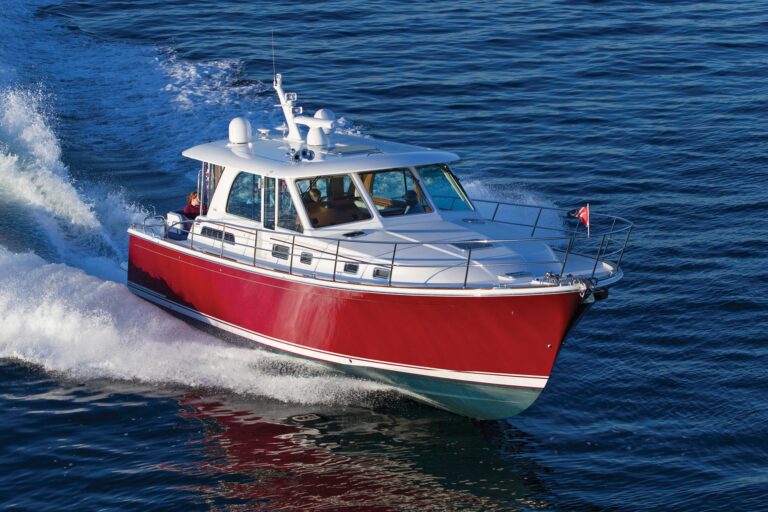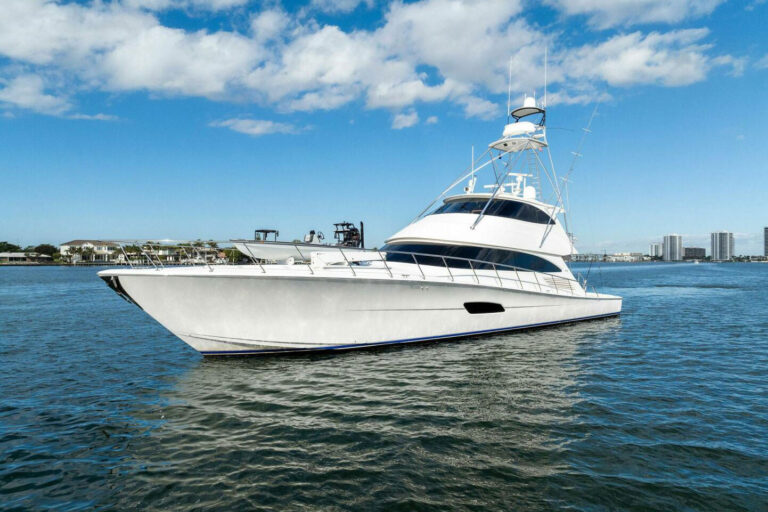In a market that overflows with multiple-function chart plotters-also serving as fishfinders, radar displays, monitoring systems, etc.-the Lowrance LCX-104C is more specialized. The manufacturer states that it is primarily a fishfinder with chart plotter. However, our test of the waterproof LCX-104C revealed that its primary designation as a fishfinder in no way diminishes its performance as a chart plotter.
The LCX-104C presents sonar or the chart plotter on a full screen-or both on a split screen. The full VGA color display measures 10.4 inches diagonally, has a resolution of 640 x 480 pixels and is readable in sunlight. The sonar transmitter is powerful enough to provide depth capability of 3,000 feet. Lowrance’s ASP (Advanced Signal Processing) noise rejection system automatically optimizes fishfinding performance under typical operating conditions. A small external LGC-12w GPS/WAAS receiver provides the navigational data. The LCX-104C runs Navionics digital cartography in conjunction with Lowrance’s MapCreate custom mapping software. Two MultiMedia Card (MMC) cartridge slots facilitate simultaneous use of a Navionics cartridge and a blank data-storage cartridge or one custom loaded with MapCreate cartography. The system’s NMEA 0183 output lets it interface with other display devices, as well as the boat’s autopilot.
The data processing capability of the 104C is evident from the speed with which it redraws the screen when it’s operating as a chart plotter. The internal memory records sonar and chart plotter data and stores up to 1,000 waypoints; 1,000 event marker icons (choice of 42 icons); 100 routes, each containing up to 100 waypoints; and 10 trail records, each comprised of up to 9,999 points. Depending on the chart in use, a total of 37 levels of image zoom are available, ranging from 0.05 to 4,000 miles. The built-in map detail includes 60,000 nav-aids plus 10,000 other items of interest in coastal and the Great Lakes waters, plus extensive information about topographical details, highways, roads, streets, etc. Sonar data and position information can be saved to a MultiMedia Card (MMC) or Secure Digital Card (SDC) for permanent storage (20 minutes of data will fit on a 11.7 MB card). Data recorded on these cards can be used with the downloadable Lowrance Sonar Simulator (PC-based) software for trip analysis off the boat.
An agreeably minimal set of eight keys and a four-way cursor provide the user interface. We had no difficulty conducting an initial exploration of the system without referring to the 190-page manual. Pressing the Pages key displays the four operation programming choices: Status, Navigation, Map and Sonar. When you first turn on the system, it defaults to the map mode and will automatically acquire GPS position data. Although the unit we tested had been relocated from Oklahoma to Florida, the WAAS GPS receiver took only a few minutes to determine position (with a calculated position error of 18.7 feet).
Lowrance has dedicated five of the eight control keys to selecting modes and programming the operation-Pages, WPT, Menu, Exit and ENT. The PWR key also provides instant access to three levels of backlighting. The Screen Mode on the main menu lets you select the full range of contrast and illumination. The ZOUT and ZIN keys are used in the navigation, map and sonar modes. Pressing these two keys simultaneously creates a man-overboard mark and immediately switches the system to the navigation screen. The navigation display shows a large compass rose with an instantly understandable steering command that guides you to the MOB position. The Pages key provides access to the four primary control modes: Status (GPS), Navigation, Map and Sonar. The four-way cursor takes you through the on-screen menu.
Pressing the Menu key in any of the primary modes first calls up a set of choices specific to a particular mode. The second operation of the Menu key presents the 13-item main programming screen. Five of these items are accompanied by sub-program selections. The Exit key allows immediate withdrawal from any programming mode. You can see in the on-screen prompts, which appear three seconds after you make a programming selection, the attention Lowrance has paid to making the system user-friendly. The prompt clearly states the purpose and function of the choice, reducing the need to refer to the operation manual. Overall, the setup and control logic of the LCX-104C are straightforward and among the best we have tested.
In Sonar Mode, the LCX gives you five display choices-full screen sonar chart, split zoom sonar, split frequency (50 and 200 kHz), digital data (on/off) and FlashGraf, a simulation of the circular-dial flasher type fishfinder previously mentioned. To suit your preferences, you may modify the relative sizes of the windows in which multiple source data appears.
The Lowrance Skimmer sonar transducer used with this system is typically mounted on the transom in a kick-up bracket, attached to a trolling motor or installed within the hull. Transducers are available as 50, 200 or dual 50/200 kHz units. Most contain an internal sensor for water temperature. Lowrance states that the transducer will operate at speeds up to 61 knots, a claim we could not verify aboard our slow boat. A conventional through-hull transducer is also available for use on larger boats. The system we tested used a separate paddle wheel water-speed sensor. The LCX-104C can also monitor up to three temperature sensors. Typically one would be internal to the transducer while the other two might be used to monitor the water temperature in live bait wells (or perhaps of at least equal interest, the temperature in the beer cooler).
Lowrance includes its MapCreate 6 custom mapping accessory pack with the LCX-104C. This nifty system is comprised of two MapCreate CDs, software, an MMC card read/write unit (available in both USB and parallel port versions) and a 16MB MMC. Basically, the accessory interfaces with a PC to create custom maps and database selections for the area in which the boat is operating. Although the maps are not substitutes for the Navionics marine charts, they do contain a wealth of useful navigation data. They can also be used to search for and locate specific terrestrial addresses and facilities and will depict minor roads and streets in detail. The provision of two waterproof MMC card slots allows ready reference to the databases from a Navionics chart cartridge and from a user-formatted MapCreate cartridge. Price: about $2,400.
Contact: Lowrance, (800) 324-1356; www.lowrance.com








